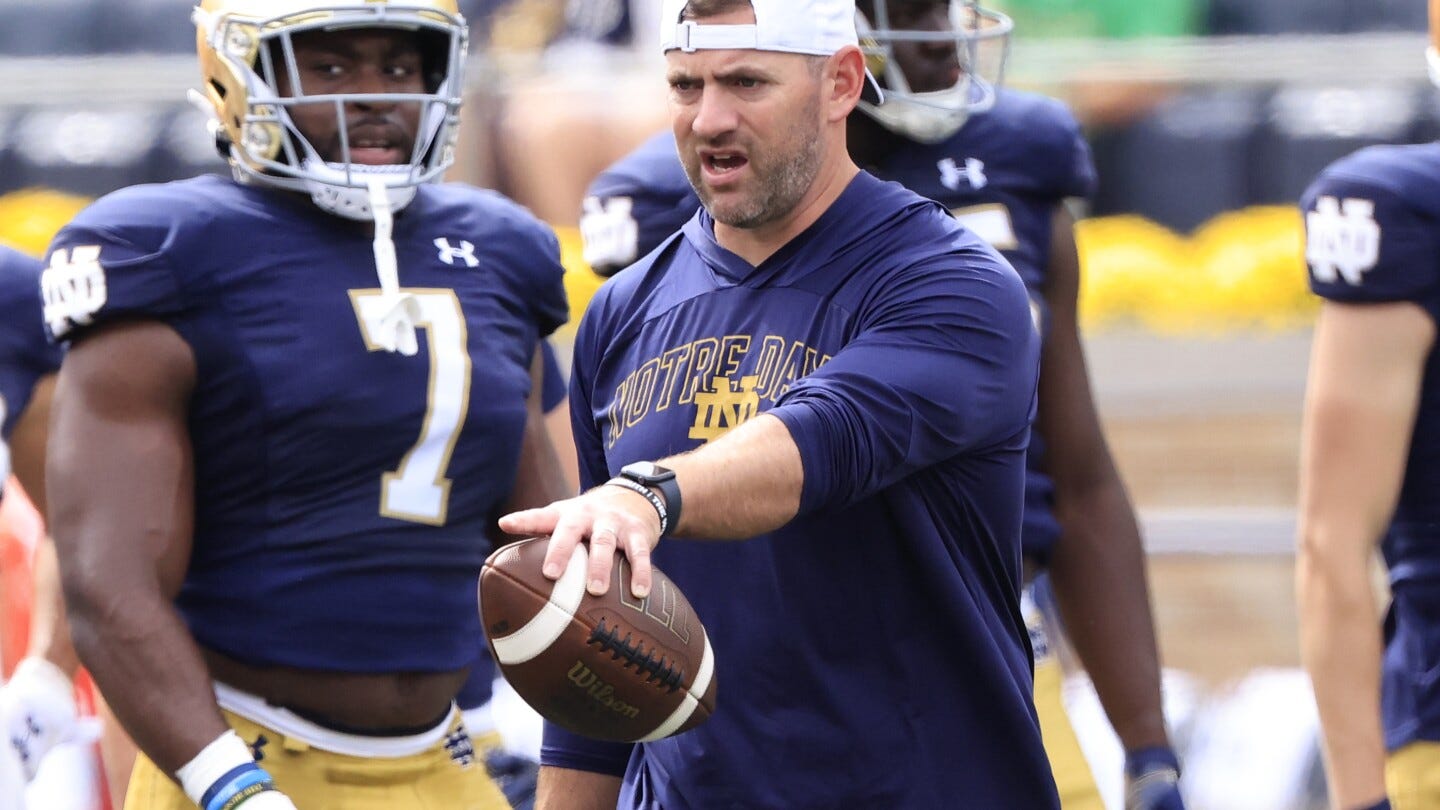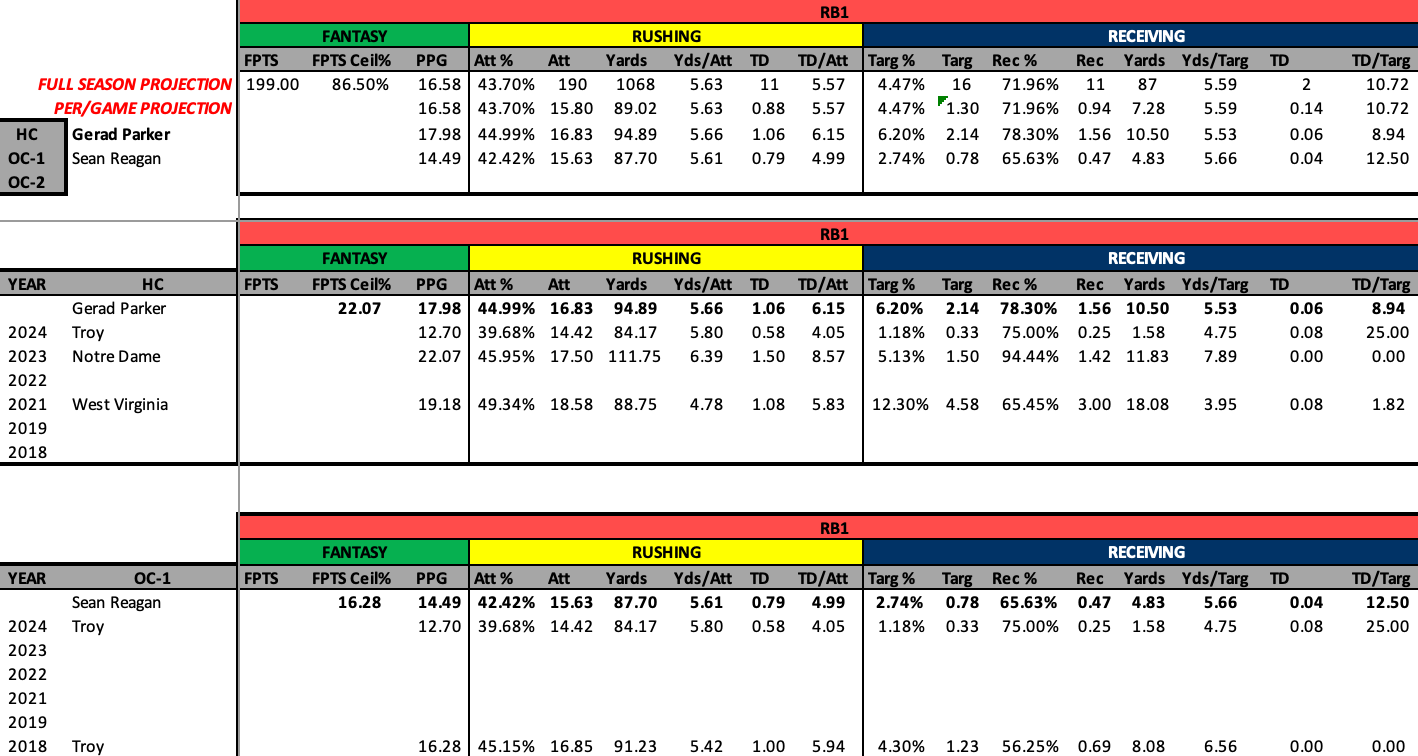The Trojans Have Been Weakened, Yes, But I'm Not Out Yet
All my life I've lived by a code and the code is simple: honor the gods, love your woman, and defend your country.
- Hector, Troy (2004)
All of my (adult) life I’ve lived by one code, and the code is simple: follow the volume and riches will follow.
There was none more voluminous than Troy runner Kimani Vidal in 2023. That season, of course, was staffed by a different crew; John Sumrall occupied the role of head coach but he moved on to Tulane the following offseason.
Gerad Parker then took over as head coach after a successful season at ND as offensive coordinator. Parker’s RB1 in 2023, Audric Estime, was also one of the heaviest touch players that season (210 carries). While Parker had no connection to that Troy offence that saw Vidal lead the FBS in carries, I’m sure he took note of that season as it was an extremely successful one. Even more so now that his Trojans are coming off a 4-7 season.
Parker and his staff vowed to run a committee in 2024 and run a committee they did (for most of the year, that is). To my surprise, and I assume the surprise of many others, former Troy senior RB Damien Taylor is actually coming off a 1000 yard rushing season. It’s true, look it up.
However, this stat is misleading. Taylor rushed for more than 100 yards in a game only four times in 12 appearances, scoring over 10 points in PPR formats five times, and seeing 20 touches or more only twice. Nearly 270 of his 1010 yards were accumulated in two appearances near the end of the year.
That being said, those two games occurred during Taylor’s final five appearances, and over that time span Taylor saw 15, 28, 18, 16, and 23 touches. He also scored five of his seven TDs over this time span. Most importantly for Parker, Troy won three out of their last five games… coincidence? I think not!
The formula for turning this ship around in 2025 may very well be a steady diet of the same medicine. Question marks at QB and the departure of Taylor (173 carries) plus his wingman, Gerald Green (111 carries), creates an opportunity for new names to emerge. Enter Georgia Tech transfer Trevion Cooley, who is a fifth year player coming off a red shirt in 2024; and Bethune Cookman (FCS) transfer Dennis Palmer, who was a true freshman in 2024.
But given that the staff got a good view of Taylor last offseason and still vowed to run a committee, should we be worried that that will be the case again in 2025? While Parker’s play calling experience is limited, the small sample of data does make a pretty compelling argument that the answer to that question will be ‘no’, so long as they have a guy they like.
Coaching & System
RB1 PPG AVERAGE — HC: 18 — OC: 14.51 (half ppr)
Parker brought over Sean Reagan, whom he had met during his time at WVU, to be his offensive coordinator. Reagan served as the pass game coordinator, QBs coach, and TEs coach during his tenure with the Mountaineers.
Prior to his stint in Appalachia, Reagan was already on the staff at Troy from 2011 to 2018 in various capacities, including co-OC in 2018 (we’ll get to this season shortly). He also served as RBs coach from 2015 to 2017.
Parker’s play calling experience includes two seasons at WVU (2020-21), ND (2023), and this past season at Troy. In each of Parker’s four seasons as either the OC or HC, there has been a RB who ran for more than 1000 yards (Leddie Brown at WVU ‘20-21, Estime at ND ‘23, Taylor at Troy ‘24).
However, with the exception of Estime, each of these players just barely achieved this feat. Leddie Brown’s production was bolstered by his receiving usage, which included an additional 217 yards in 2021, and 202 yards plus two scores in 2020 (shortened season—10 games).
Brown’s PPG average isn’t included in the table because it was a shortened season, but given that he averaged 19 PPG in half ppr formats the following year with virtually the same stats over 12 games, I’d estimate that he was close to 23-25 PPG in 2020.
Estime averaged a healthy 22 PPG when Parker called the offence in 2023, and then we have Damien Taylor who averaged around 12 PPG in 2024.
Now looking at Reagan’s history, the only time he held the title of OC/co-OC outside of this past season was the aforementioned 2018 Troy team. BJ Smith ran for 1186 yards and 13 scores on 219 carries with minimal receiving usage. When Reagan was solely in charge of the RBs (2015-17), there were two 1000-yard rushers.
Looking at the histories of each coach, it’s bizarre that they publicly vowed to run a committee last season. I suppose they felt equally as good (or bad) about both Taylor and Green. But now both move on, and given the patterns of each coach’s RB usage, I find myself wondering if there is a lucrative opportunity here for CFFers.
Unsurprisingly, both coaches average a run-heavy split in their play calling (54/46 for Parker, 56/44 for Reagan). Their offences move at around an average pace, but more on the slower end of the FBS average.
According to CFBWinningEdge’s database, the Trojans returns 60% of the starting snaps along the OL from a year ago (I’m guessing this means 3/5 starters). Troy was a ‘Gap’ run scheme in 2024, with the most common plays including: wham, inside zone, zone counter, counter, QB sneak, duo and lead.
Dennis Palmer (5’10, 200)
2024 RUSHING STATS: 159 - 706 - 5 (8 games)
Observing the season-total in rushing for Mr. Palmer, the aggregate numbers probably won’t wow the reader.
However, on closer inspection we see that he did his work in only eight games. What’s more, he didn’t start handling grown-man work until October 19, or his third game of action. From that point onward, he was a 20+ touch per game dude for B.C.
The hairs on the back of my neck were instantly raised when I—for a moment—thought I had stumbled upon a cool parallel here with another true freshman who started handling heavy work on the week of October 19—Breece Hall. Except, he actually broke out the week prior, on October 12. However, I was still comforted by the fact that my near encyclopedic knowledge and memory of CFF lore still remains as dynamic as ever:
Palmer averaged over four yards per carry in almost every game he played last season, which is impressive for a true freshman. He also had a game where he caught five passes, suggesting that he could be a tool in the receiving game as well. However, on the whole, he was not used frequently as a pass-catcher at B.C.
From the limited photos that I’ve seen of him, he looks shorter than 5’10, and heavier than 200 pounds. He looks like a bowling ball. Maybe it’s just the 34 jersey number that makes one look fatter, I don’t know.
As you would expect with most FCS players, Palmer was an unrated prospect coming out of high school. He attended Jensen Beach High, in Florida, and recorded over 5000 rushing yards and 60 TDs in his high school career.
Both he and Cooley were brought in during the spring portal window after Damien Taylor’s departure. Like Cooley (discussed below), Palmer’s name could be a hot one in summer drafts if there are positive updates out of Troy’s fall camp. For now, I don’t view him as a player worth prioritizing outside of an end-of-draft dart throw.
Considering the success rate of former FCS RBs in the FBS, whether that be the P4 or G5 levels, I probably would take a chance on Palmer over Cooley as things currently stand.
Trevion Cooley (5’10, 205)
2024 RUSHING STATS: 6 - 26 - 0 (1.2 PPG in three games played)
Cooley is coming off a redshirt season where he only appeared in three games at Georgia Tech. He had previously played in at least seven games in his first three seasons, starting his career at Louisville in 2021, which was actually his best year to-date with 431 yards on 86 carries.
Remarkably, his yardage has actually trended down every season since then, only rushing for around 270 yards in 2022 and 2023 each. However his efficiency stats are encouraging, averaging 4.3 or more yards per opportunity every year including this last one where he appeared in a limited sample.
He’s also shown himself to be a decent receiver with 173 yards and two TDs during his true freshman season with the Cards. Those outputs came out of 12 receptions on 17 targets in 12 appearances. He also surpassed 100 yards receiving in 2023, his first year with Georgia Tech, with 112 yards and a score on 11 receptions (14 targets).
So in the limited opportunities he’s had, he’s done a pretty good job. The question would then be that if he’s so good, why didn't he get more opportunities? And that is a legitimate question with him, but the good news is this transfer is a move down a level, rather than a lateral move like he did previously going from Louisville to Georgia Tech. From that perspective there’s room for optimism that Cooley could secure a prominent role with his new club and excel given the opportunity.
It’s also important to note that WR Devonte Ross (who went over 1000 yards receiving) is also leaving. So this whole offence is getting a facelift in 2025. The QB position left much to be desired in 2024 but who knows how that plays out this upcoming season. Of course, there will presumably be a replacement plan for Ross too (maybe former UGA/Mississippi State WR RaRa Thomas).
Either way, there are a lot of opportunities here for new faces to emerge in 2025. Cooley doesn’t strike me as a player who will be an absolute lock to take over the Troy backfield immediately, but he is a guy who’s career arc tells me he wants to play a lot in 2025.
Given that we don’t even know currently if he’ll be RB1 this upcoming season, I don’t see Cooley as anything more than a late round dart throw in best ball drafts. However, depending on what happens in fall camp, this is a player who could rise significantly in value amongst the CFF crowd in a very short time. ◾
If you enjoyed this content and would like to read more, I recommend joining the Pigpen, a community of thousands of degenerate college football fans:
Sample from 2018-2024 excluding 2020.








